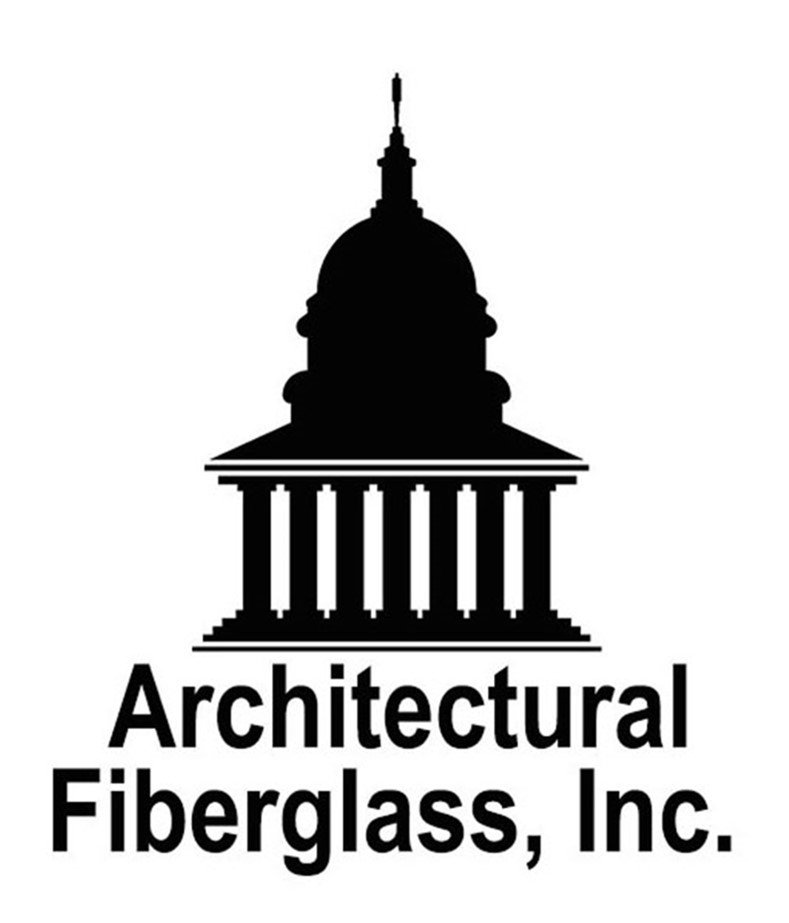Clock Tower Puts Beacon In a New Light
This article appeared in the Akron Beacon Journal, October 9, 2005.
$500,000 project does more than give time, temperature
By Bob Dyer
Beacon Journal staff writer
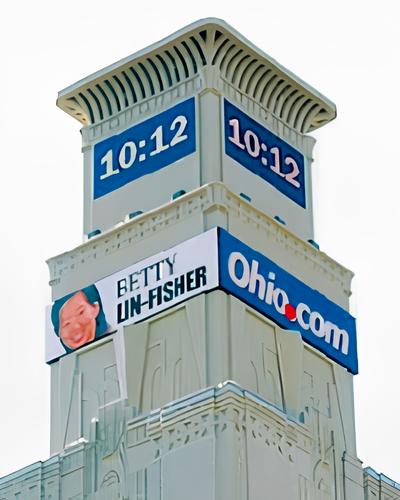
KATHY KOCHANSKI / Special to the Beacon Journal
The Beacon Journal’s clock tower will display the time, temperature, news, advertising and event information.
The term “Beacon Journal clock tower” has just become obsolete.
This time, you’re getting a lot more than a clock. This thing is a scoreboard. Or maybe a video game. We’re not exactly sure yet.
We can flash it, blink it or stream it. We can roll it, scroll it or hold it. We can change the colors. We can even give you full-color animation.
Yes, you’ll still get the time and temperature, just as you have for the last 66 years. But our new $500,000 tower will also provide news, advertisements, event information and whatever else our mad programmers dream up.
The lower display consists of a four-sided message board, each side 12 feet wide and 3 ½ feet high. That’s where the news and ads will go.
The upper screens, 7 feet by 3 ½ feet, will alternate between the time and temp, “Akron Beacon Journal” and the logo of the newspaper’s Internet partner, Ohio.com.
Forget the neon lights that went up in 1939 and the gaudier ones that went up in 1955. Forget the floodlights that went up in 1966. Today we’re into pixels.
Each “bulb” is actually three tiny diodes — red, green and blue. Now, an artist would tell you that the three primary colors are red, yellow and blue. But to create the entire spectrum of light, the magic trio is red, green and blue.
The company responsible for the displays, Daktronics, is the same firm that created the gargantuan scoreboard at Jacobs Field and thousands of other sports and entertainment displays around the world.
Short of a hologram, this is about as sophisticated as a sign can get.
By contrast, the reconstruction of the tower itself marks a return to the past.
When the Art Deco building was designed in 1930, it was owned by a different newspaper group — Scripps-Howard, whose logo is a lighthouse. So the original tower was supposed to resemble a lighthouse.
Each time the clock was replaced, the revamped tower moved farther from the original style. But now, thanks to sketches by Beacon Journal graphic advertising designer Mike Ayers, the tower is much more in keeping with the original vision.
Put those two elements together — ancient tower, ultra-modern electronics — and we’re “back to the future,” as Beacon Journal publisher Jim Crutchfield puts it.
First, the future.
Northern lights
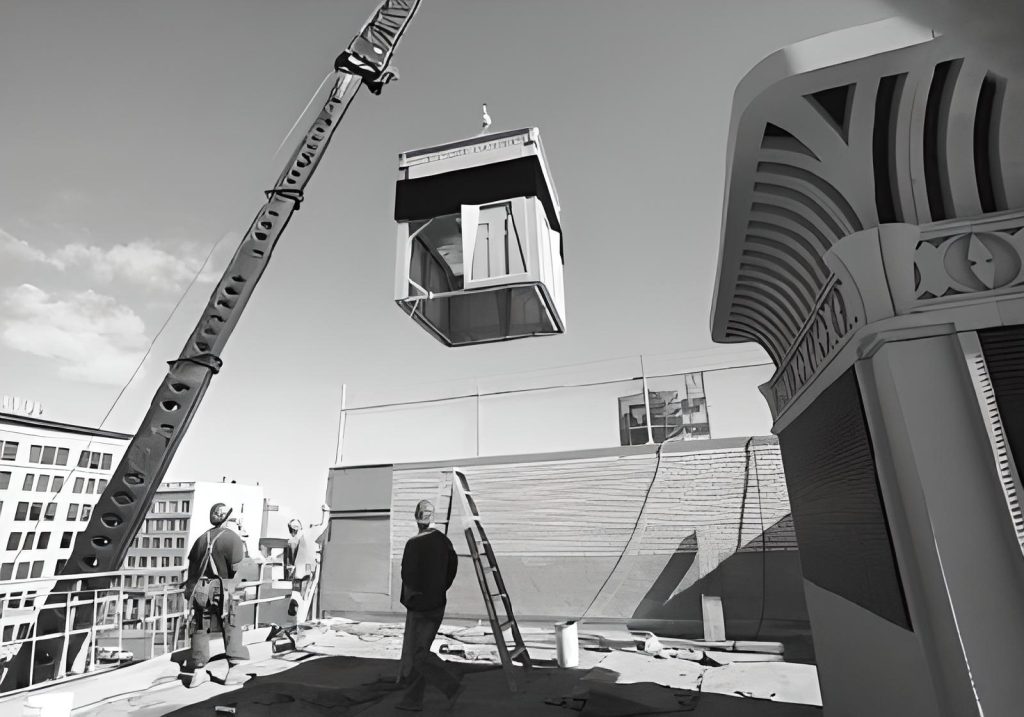
The new boards came to life in a little town near the Big Sioux River on the plains of eastern South Dakota.
This is a region where the roads run either directly north and south or directly east and west. A lot of them are dirt, and all of them are flat.
If you take the biggest one going north from Sioux Falls, you’ll arrive about an hour later in Brookings, S.D.
“Population 18,504,” says the sign — and fully 10 percent of those folks work at Daktronics.
What on Earth is this sophisticated company doing in the middle of the prairie? Simple. It was a solution to brain drain.
Brookings is home to the state’s largest university, 11,000-student South Dakota State. By 1968, two SDSU engineering professors had grown weary of watching their best and brightest flee after picking up diplomas. So the profs decided to launch a company that would require the services of electrical engineers.
They incorporated as Daktronics — a blend of Dakota and Electronics.
The early projects were rudimentary sports scoreboards and simple electronic voting machines for state legislatures.
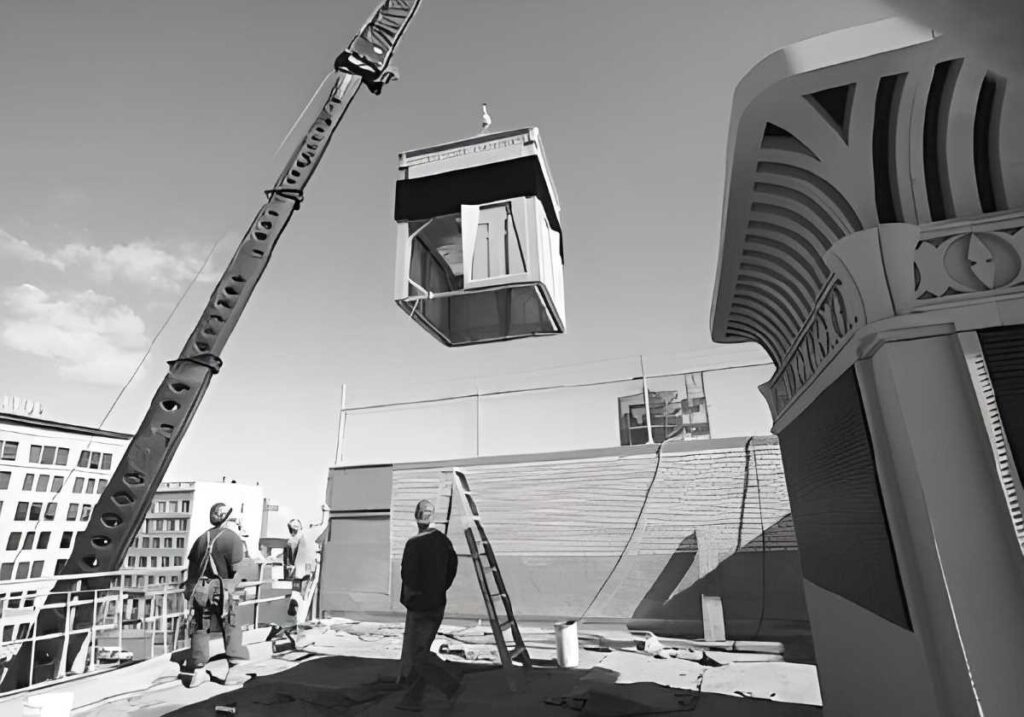
KEN LOVE/ Akron Beacon Journal
A crane hoists segments of the Beacon Journal’s clock tower into place Sept. 27 at 44 E. Exchange St. Architectural Fiberglass Inc. of Akron made synthetic stone that looks and feels like the real thing.
But today, Daktronics is the worldwide leader in programmable displays, a force so powerful that it drove the gigantic Sony Corp. right out of the North American scoreboard business.
Daktronics has signs and scoreboards all over Las Vegas… at Times Square… at every Olympic venue since 1988… at 1,000 colleges… and at 80 percent of the arenas and stadiums used by professional baseball, football and basketball teams — including not only the Jake but Cleveland Browns Stadium and The Arena Formerly Known As Gund (aka Quicken Loans Arena).
Feeling blue
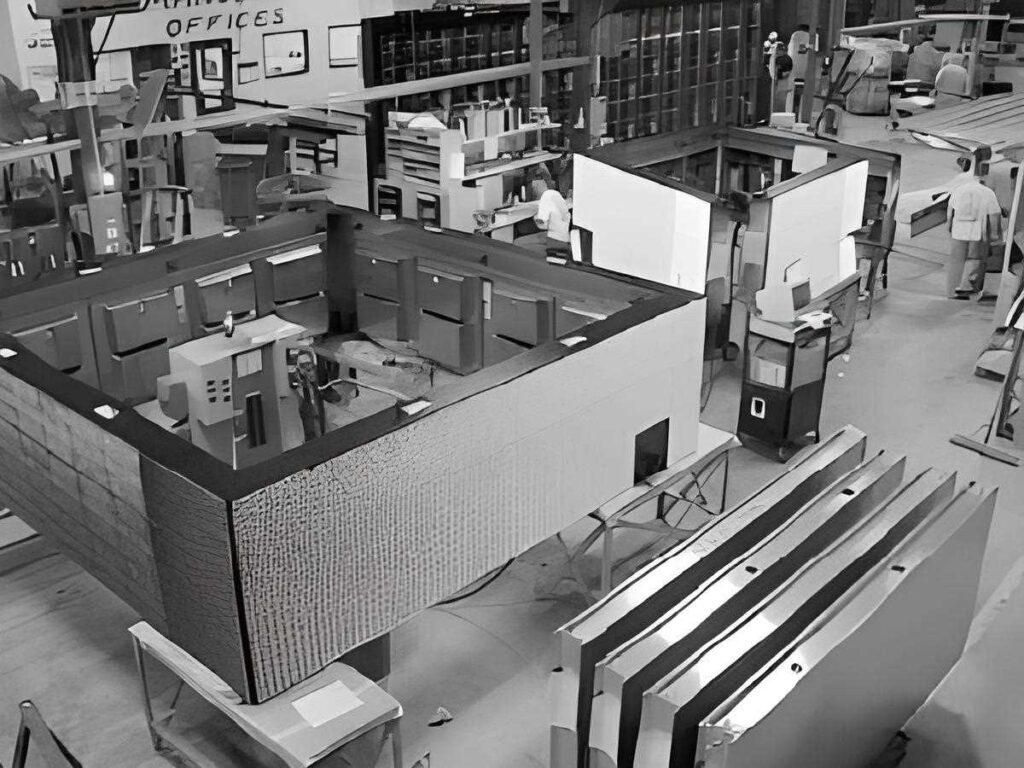
Photo courtesy of Daktronics
Workers test the Beacon Journal’s wraparound message board at the Daktronics factory in Brookings, S.D.
The company’s big breakthrough came in the mid-1990s. Until then, Sony had so ruled the market that the brand name JumboTron had nearly become the generic name for video scoreboard.
But Sony’s big CRTs (cathode-ray tubes, same as traditional televisions) were outrageously expensive, ungodly heavy and lacking in brightness. And they seemed to break down a lot.
The solution appeared to be light-emitting diodes, or LEDs. But nobody could figure out how to make decent blue ones. The red ones were fine. The green ones were fine. But the blue ones simply weren’t bright enough.
Blue was tricky because blue has the shortest wavelength of visible light.
For 20 years, all of the biggies — Sony, RCA, Hewlett-Packard, Matsushita — had been pounding away in their research labs, always in vain. Finally, a guy working for little Nichia Chemical Industries in Japan figured it out.
All of a sudden, you could create a huge full-color display with LEDs.
Daktronics produced its first LED video scoreboards in 1997, shipping them to the University of Oklahoma, Clemson and Washington State.
Since then, the company’s business has exploded. Daktronics has products in 70 countries and so many orders that it is constructing a 100,000-square-foot addition to the 250,000-square-foot factory it already owns on a 40-acre complex next to Interstate 29.
Sports is only one element of the boom. The current rage is commercial projects such as the Beacon Journal tower. Those range from small, one–color signs in front of fast-food restaurants to the 42-by-58-foot full-color monster headed for the Emperor Hotel and Casino in Macau (an island next to China with even more gambling action than Vegas).
A third niche is highway signs. Daktronics has done business with 20 state transportation departments as part of the growing national trend toward “Intelligent Transportation Systems,” which use display boards to warn motorists of delays.
How hot is that product line? If Daktronics never gets another order, the factory will be busy through March.
The operation is already running seven days a week, with three shifts on weekdays. The “jobs available” bulletin board contains so many pieces of paper that the hallway looks like a ticker-tape parade gone awry. The project manager for the Beacon’s $218,000 order, Trevor Moser, is all of 22 years old, straight out of SDSU.
“Growth is always a delicate balance,” says vice president Reece Kurtenbach, son of one of the co-founders.
As business challenges go, that’s a nice one to have.
The inside of the factory is the electronics version of Willie Wonka. Big, funky, computerized machines do everything from fabricating the metal for the support cabinets to cutting the printed circuit boards, popping in the resistors and soldering entire boards with one swipe.
But there would be no place to hang the Beacon’s fancy new displays if it weren’t for a considerably lower-key company located in an ancient part of Cleveland.
History of the Beacon Journal Tower
June 1930: Building opens at 44 E. Exchange St.
November 1939: First clock installed. Oval shape. Has two sides, facing north and west. Uses neon tubes and 60 bulbs around the edge that tick down the seconds.
April 1955: New four–sided clock installed. Uses red numbers and white letters accented with green and yellow neon tubing.
November 1966: Revolving clock tower erected. Two sides feature big red plastic “BJ” letters. Other two sides alternate between time and temperature using 152 white floodlights, 45 watts each.
October 2005: “Back to the future” tower unveiled. Tower goes back to original Art Deco style of 1930, while two sets of display boards use cutting–edge electronics to display numbers, letters, logos and animation.
Re-create the past
Bessemer Avenue is in a well-worn neighborhood on the city’s near east side. Inside a tall metal fence topped with barbed wire, behind the “Beware of Dog” sign, you’ll find a small group of folks who are in the business of making new stuff look old.
Or old stuff look new. Depends how you want to think about it.
Much like the tubes-to-LEDs breakthrough that sent Daktronics into the stratosphere, this business is thriving because of a technological development of its own.
The Beacon’s original tower consisted of Indiana Limestone. Most of it still does. But near the top, where the electronics start, it is now fiberglass masquerading as stone.
Architectural Fiberglass Inc. is able to mimic all kinds of masonry for a whole lot less money.
One of the company’s best customers is Coon Restoration of Louisville, the firm that did the heavy lifting on the Beacon’s project.
“We’re trying to re-create the past, not reinvent it,” says Steve Coon, whose company has renovated such places as the Cleveland Convention Center, the Stark County Courthouse and churches throughout Stark and Summit counties.
Because of the huge cost savings, historic buildings that once may have been torn down now can be restored.
The initial problem with fiberglass was its lack of durability. Ultraviolet rays from the sun ate it alive. But now, with the development of UV inhibitors, the life expectancy of projects such as the Beacon tower is at least 50 years.
Reworking the tower with stone would have cost $700,000 to $800,000, rather than the $75,000 that is going to Architectural Fiberglass.
Cost is not the only factor. Another is speed. During a previous job, Coon says, “we were waiting a year and a half for a piece of terra cotta.”
Fiberglass also is far easier to handle because it is dramatically lighter. The Beacon’s new synthetic stone weighs about 2 ¼ tons — 200 times less than the real thing, according to Coon.
But put the stone and fiberglass side by side and you’re hard – pressed to see any difference. They even feel the same.
Jigsaw puzzle
In some ways, replicating stone is every bit as exacting as lining up diodes.
Working from detailed blueprints, the folks at Architectural Fiberglass use a variety of media — wood, foam, fiberglass, nails, glue, whatever it takes — to build an exact replica of what they’re trying to create.
Next, they make a mold of the replica.
The mold is then spray-painted to ensure that all the different substances have the same general texture.
When the mold is finished, it is sandblasted to create pores. Then a gel coat is applied to create the desired texture.
Only then is the fiberglass sprayed into the molds.
There’s even more to it than that — and a lot of it is unpleasant. The shop is loud and smelly and staffed by people wearing respirators and plastic gloves. Electric sanders, high — volume spray guns and big fans create a constant din.
Even more fun: “Almost every chemical in here will self-ignite” if left alone after it is mixed, owner Mike Dobronos says. When that happens — which is often — the workers simply carry the flaming containers to the rear of the shop and let them burn out on top of big drums filled with water.
The private, 25-employee company uses fiberglass to mimic a wide variety of materials. Walking through the shop on a sunny July day, you see tall gold-colored crosses destined for a church in Toronto and a wooden model of a huge baseball glove expected to wind up at a major league ballpark.
Coming together
The old stuff from Cleveland and the new stuff from South Dakota were introduced to each other during the final week of September.
The hulking fiberglass sections were raised to the top of the parking deck with a crane, as were two big wooden boxes containing the electronics. They were assembled on the deck, then lowered to the street before being lifted to the top of the tower in two sections on Sept. 27.
End of story? Not quite.
A placed called “the Beacon” needs a light. So the company’s facilities manager, Mike Dean, had a plan: Take a 10,000 — watt light, stick it on top of the new tower and shoot that puppy straight up into the night sky.
The light is so bright that Dean had to get special permission from the Federal Aviation Administration. The FAA cleared him for takeoff in July — which cleared the way for some additional creativity.
Using filters, the Beacon’s beacon could shine red on Christmas… green on St. Paddy’s Day… perhaps gray for January and February and March….
How long will the new tower last? Well, the life expectancy of the LEDs is almost 12 years, and their modular design makes them easy to replace. The tower should be good for more than half a century.
But if tradition holds, long before the tower crumbles, somebody in a corner office will probably decide it’s time for a new look.
Holograms, anyone?

